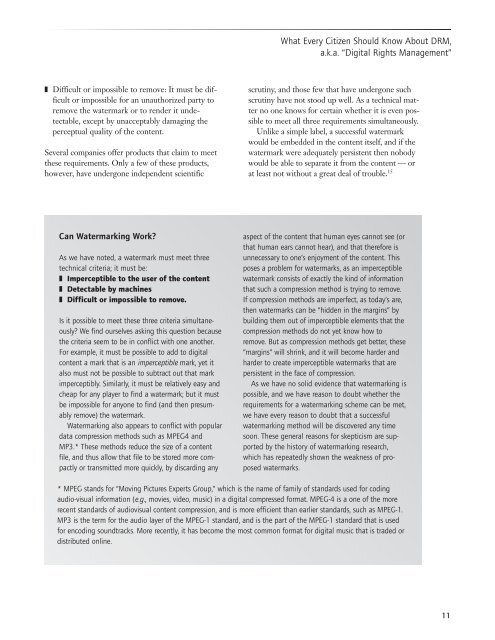What Every Citizen Should Know About DRM, aka - Public Knowledge
What Every Citizen Should Know About DRM, aka - Public Knowledge
What Every Citizen Should Know About DRM, aka - Public Knowledge
Create successful ePaper yourself
Turn your PDF publications into a flip-book with our unique Google optimized e-Paper software.
<strong>What</strong> <strong>Every</strong> <strong>Citizen</strong> <strong>Should</strong> <strong>Know</strong> <strong>About</strong> <strong>DRM</strong>,a.k.a. “Digital Rights Management”❚ Difficult or impossible to remove: It must be difficultor impossible for an unauthorized party toremove the watermark or to render it undetectable,except by unacceptably damaging theperceptual quality of the content.Several companies offer products that claim to meetthese requirements. Only a few of these products,however, have undergone independent scientificscrutiny, and those few that have undergone suchscrutiny have not stood up well. As a technical matterno one knows for certain whether it is even possibleto meet all three requirements simultaneously.Unlike a simple label, a successful watermarkwould be embedded in the content itself, and if thewatermark were adequately persistent then nobodywould be able to separate it from the content — orat least not without a great deal of trouble. 15 11Can Watermarking Work?As we have noted, a watermark must meet threetechnical criteria; it must be:❚ Imperceptible to the user of the content❚ Detectable by machines❚ Difficult or impossible to remove.Is it possible to meet these three criteria simultaneously?We find ourselves asking this question becausethe criteria seem to be in conflict with one another.For example, it must be possible to add to digitalcontent a mark that is an imperceptible mark, yet italso must not be possible to subtract out that markimperceptibly. Similarly, it must be relatively easy andcheap for any player to find a watermark; but it mustbe impossible for anyone to find (and then presumablyremove) the watermark.Watermarking also appears to conflict with populardata compression methods such as MPEG4 andMP3.* These methods reduce the size of a contentfile, and thus allow that file to be stored more compactlyor transmitted more quickly, by discarding anyaspect of the content that human eyes cannot see (orthat human ears cannot hear), and that therefore isunnecessary to one’s enjoyment of the content. Thisposes a problem for watermarks, as an imperceptiblewatermark consists of exactly the kind of informationthat such a compression method is trying to remove.If compression methods are imperfect, as today’s are,then watermarks can be “hidden in the margins” bybuilding them out of imperceptible elements that thecompression methods do not yet know how toremove. But as compression methods get better, these“margins” will shrink, and it will become harder andharder to create imperceptible watermarks that arepersistent in the face of compression.As we have no solid evidence that watermarking ispossible, and we have reason to doubt whether therequirements for a watermarking scheme can be met,we have every reason to doubt that a successfulwatermarking method will be discovered any timesoon. These general reasons for skepticism are supportedby the history of watermarking research,which has repeatedly shown the weakness of proposedwatermarks.* MPEG stands for “Moving Pictures Experts Group,” which is the name of family of standards used for codingaudio-visual information (e.g., movies, video, music) in a digital compressed format. MPEG-4 is a one of the morerecent standards of audiovisual content compression, and is more efficient than earlier standards, such as MPEG-1.MP3 is the term for the audio layer of the MPEG-1 standard, and is the part of the MPEG-1 standard that is usedfor encoding soundtracks. More recently, it has become the most common format for digital music that is traded ordistributed online.





